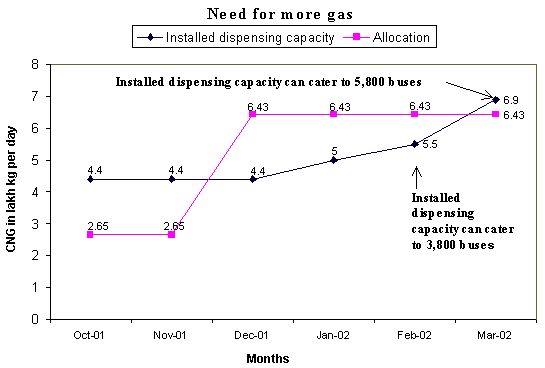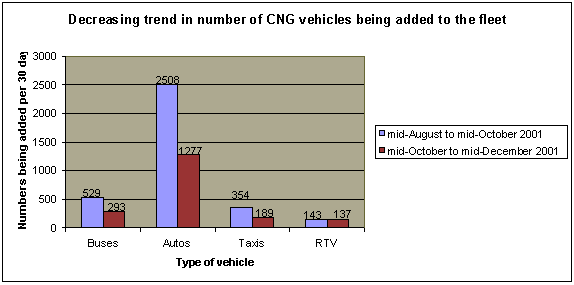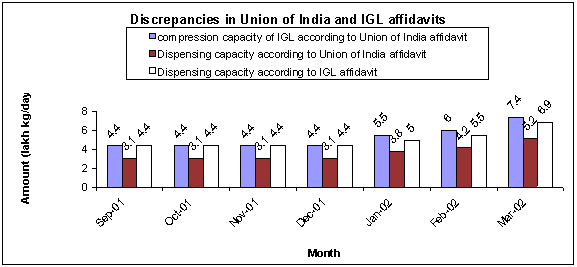|
|
|
|
Status
of implementation of the Supreme Court order to convert public
transport buses to compressed natural gas (CNG) March 4, 2002
|
|
|
|
The
Supreme Court had extended the deadline till January 31 for
the phase out all diesel buses and to replace these with CNG
fuelled buses.
The position on date is that very little has happened. The
Delhi government has said that it cannot implement the order
in this timeframe and has asked the court to grant an extension
- till August 2004. The Union government agrees with this
schedule and in addition would like the court to ignore its
earlier order and to allow diesel buses complying with Euro
II norms (applicable norms for Delhi) to operate in the city.
The following status reports and affidavits have been filed
in the court by government agencies on the status of implementation
and we are presenting a brief analysis of the often, contradictory
positions in these documents:
a. Status Report 1&2 submitted by the
commissioner cum secretary (transport), Government of NCT;
b. Affidavit from the Union of India; and,
c. Affidavit from Indraprastha Gas Limited
(IGL).
1. Is there adequate gas to implement the court
order?
The issue about gas supply is simply that the Union government
has to allocate more gas to Delhi to implement the court order.
Since the last hearing, the Union government has roughly doubled
its earlier allocation to Delhi's vehicular fleet. But even
this increased allocation made in January 2002 - by diverting
gas from a single user, Maruti Udyog Limited - will be totally
inadequate for implementation of the Supreme Court order.
In fact, it will not even meet the full needs of the 10,000
buses ordered by the court.
To meet the needs of current and projected vehicles in the
city - the city requires a mere 4.8 per cent of the current
supply of gas by the HBJ pipeline. The production of gas in
the South Bassein gas fields has also increased over the last
2-3 years. But the increased production has been allocated
to industry, ignoring the Supreme Court directive for Delhi.
The Ministry of Oil and Natural Gas (MoPNG) has increased
allocation to Delhi from 3.87 lakh kg/day to 7.9 lakh kg per
day (0.48 mmscmd to 0.98 mmscmd) in January 2002.
The total gas allocated to the transport sector is now 6.4
lakh kg/day (0.8 mmscmd). The rest is for city gas distribution
and internal consumption.
The total gas projected for vehicles (all buses, autos, cars,
taxis) in Delhi is 16.1 lakh kg per day (2 mmscmd), which
is a mere 4.8 per cent of the current production from South
Bassein fields which is supplied through the HBJ pipeline.
The increased allocation of gas to Delhi has come because
the government decided on January 1, 2002 to withdraw the
total supply of gas to one user, Maruti. Its supply was terminated
on January 23, 2002. The abrupt disconnection of gas to Maruti
smacks of petty action against a member of the Environment
Pollution (Prevention and Control) Authority (EPCA) as it
was equally feasible for the government to reduce the allocation
of gas to all users to make provisions for Delhi.
In fact, if only 3.7 per cent of gas was cut on a pro-rata
basis from the current consumers and diverted to Delhi, it
would be sufficient to meet the needs of all current and projected
vehicles running on CNG.
There has been a practice of pro-rata cuts on all consumers
to make space for new allocation. So, for instance, when the
Supreme Court had directed that gas should be supplied to
consumers in Agra and Mathura to reduce pollution in the Taj
trapezium, this was done by cutting the gas of all consumers
on a pro-rata basis. This lead to minimal disruption of all
users and did not penalise any one industry group.
The supply of natural gas has also increased from the South
Bassein fields in the last few years - from 38 mmscmd to 41
mmscmd. This has happened after the court order of July 1998,
and instead of using this increased production for implementation
of the court, the government has chosen to allocate it to
industries. So:
- Reliance
got an addition 0.7 mmscmd
- Essar
got an additional 0.4 mmscmd
- Gujarat
State Fertilizer Corporation got an additional 0.4
mmscmd
- GIPCL
(power generating company in Baroda) got 0.5 mmscmd
(interestingly this gas is being supplied without
any allocation by the government and as a "matter
of favour"
- IPCL-Dahej
got an additional 0.85 mmscmd
|
|
The
Union government must be asked to enhance the allocation for
Delhi's vehicular fleet. Without this, the court order cannot
be implemented.
2. How many buses can be supplied gas currently?
As per IGL's affadavit the status as date is:
- CNG
allocated to the transport sector by MoPNG is 6.4
lakh kg per day.
- Total
dispensing capacity of IGL is 5.5 lakh kg per day
in February 2002.
- The
total gas needed by all the vehicles on the road in
January-February is 5.49 lakh kg per day. This means
as of date, IGL can just about supply enough gas to
all the vehicles on the road. (See table 1: CNG needed
per day to meet the full demand).
- The
total CNG buses on road are 3800. Thus, as of February
2002, if all vehicles were to come for refills everyday
not a single bus can be added to the fleet.
|
|
|
Table
1: CNG needed per day to meet the full demand (February 2002)
| Type
of Vehicle |
Total
vehicles actual and projected for Feb 2002 |
CNG
needed per day per vehicle(Kg) |
Total
amount of CNG needed per day on the assumption that all
vehicles come for refill everyday(lakh kg per day) |
| Buses |
3,800 |
70 |
2.66
|
| RTVs |
1,750 |
18 |
0.32 |
| Cars |
10,350 |
4 |
0.41 |
| Taxis |
4,000 |
8 |
0.32 |
| Autos |
35,500 |
5 |
1.78 |
| Total |
58,500 |
|
5.49 |
|
| Source:
Indraprastha Gas Limited |
- By
March end, if IGL increases its dispensing capacity
to 6.9 lakh kg per day as it states in its affidavit
and also has the 55 compressors working, it can supply
gas to an additional 2000 buses and all the other
vehicles on road today.
|
|
Table
2: How many buses can be added to the fleet by March 2002
| Type
of Vehicle |
Total
vehicles projected for March 2002 |
CNG
needed per day per vehicle(Kg) |
Total
amount of CNG needed per day(lakh kg) |
| Buses |
5,800** |
70 |
4.06
|
| RTVs |
1,750 |
18 |
0.32 |
| Cars |
10,350 |
4 |
0.41 |
| Taxis |
4,000 |
8 |
0.32 |
| Autos |
35,500 |
5 |
1.78 |
| Total |
61,400 |
|
6.89 |
|
Source:
Indraprastha Gas Limited
Note: ** Projected figures for buses |
- MoPNG
has allocated only 6.4 lakh kg of gas for transport
while IGL will be in a position to dispense 6.9 lakh
kg of gas in March 2002. This means allocation is
falling short by 0.5 lakh kg per day.
- Thus
in March 2002, not only will dispensing capacity fall
short of the demand if the Supreme court order of
10,000 buses has to be implemented, the allocation
to IGL will have to be increased to 7 lakh kg per
day to cater to 10,000 buses or 10 lakh kg per day
to meet the needs to all vehicles on road today. This
is assuming that there will be no further growth in
CNG vehicles in other categories.
|
|
Delhi government and the Union government claim in their
affidavits that only 200 buses can be added to the fleet every
month as per gas dispensing capacity. According to our calculation
IGL can cater to 5800 buses by March 2002.
After March 2002, IGL cannot cater to any further growth unless
there is new allocation of gas by the Union government.
|

|
| It
is clear from the above, that all parties have shown a complete
lack of seriousness in implementing the court order; |
- The
Union government has failed to allocate enough gas
to meet the needs of vehicles. The MoPNG has not even
provided till date for the needs of the 10,000 buses,
which the court ordered in mid-1998.
- The
Delhi government has done little to expedite the clearance
of the 12-inch pipeline from Dhaula Kuan to G.T. Karnal
road, needed to set up mother and online stations
in west Delhi and increase the dispensing capacity;
- The
infrastructure provided by IGL is only now beginning
to outpace the demand for the gas. Only in March 2002,
will IGL have excess dispensing capacity and could
cater to 2000 additional buses. But after March, its
expansion will depend on the additional allocation
of gas by the Union government and the clearance for
the pipeline by the Delhi government
|
|
| Therefore,
all these agencies have worked to ensure that the supply position
remains tight and provides them with an easy excuse to allow
the diesel buses to ply. |
3. How will the demand of other category of vehicles
be met after March?
By end March 2002, there will be enough gas
(allocation and supply) to meet the needs of 5,800 buses along
with the fleet of other CNG vehicles on the roads today. This
assumes that there will be little or no increase in the CNG
fleet (except buses) based on the experience of the last few
months. In January, for instance, no new CNG vehicles have been
registered.
This is because the government (through IGL) has made it clear
that it will not supply gas to private vehicles even though
this would have lead to major improvements in air quality. It
has also clarified that the court order for converting to CNG
is not applicable to autos and taxis.
This is already leading to a marked decrease in CNG vehicles.
According to data provided to IGL by the State Transport Authority
the number of CNG vehicles coming to the roads is clearly declining.
While 529 CNG buses were added to the fleet during the period
August to October 2001, only 293 CNG buses were added to the
fleet during the period mid-October to mid-December 2001. Similar
trend has been observed in the case of other vehicles as well.
|
Graph 2: Negative growth rate of CNG vehicles

|
|
- During
August to October 2001, 529 CNG buses were added to
the fleet, which decreased to 293 during the period
October-December 2001, a decrease of more than 44
per cent.
- Autos
show a drop of as much as 49 per cent and taxis almost
47 per cent.
|
|
4. Is the problem dispensing capacity (as the
Union government claims) or something else?
There is a discrepancy in the estimates given
by IGL in its affidavit and given by the Union government in
its affidavit, with regards the compression and dispensing capacity
available in the city.
The Union government affidavit puts the blame on the inadequate
dispensing capacity of the IGL as the root cause of the problem.
It states that IGL is in a position to dispense only 70 per
cent of their compression capacity. According to the Union government
by Feburary 2002, IGL can compress 6 lakh kg of natural gas
per day but can dispense only 4.2 lakh kg of this compressed
gas.
But IGL disagrees. According to IGL compression capacity is
equal to dispensing capacity so far. IGL can compress and dispense
5.5 lakh kg per day in February 2002.
Graph 3: Discrepancy in MoPNG and IGL affidavits
as regards the dispensing capacity of IGL
MoPNG claims that dispensing capacity of IGL is
70 per cent of the total compression capacity. But IGL estimates
show that their dispensing capacity matches their compression
capacity.

|
| Source:
IGL and Union of India affidavits |
IGL has estimated the total amount of CNG needed
per day in February which shows that to meet the demand for
6,900 buses, 1750 RTV, 10,350 cars, 4000 taxis, 35,500 autos,
the total CNG required per day would be 7.66 lakh kg per day.
But based on their actual observed sales everyday at the dispensing
stations they have found that about 70 per cent of the vehicles
come for refill everyday and not 100 per cent. This means their
actual per day sales is 70 per cent of the dispensing capacity,
which is 5.33 lakh kg per day. On this basis IGL estimates that
the total demand per day in February 2002 would be 5.33 lakh
kg per day.
This has been misinterpreted by the Union government to say
that IGL can dispense only 70 per cent of the compression capacity.
5. What do we want?
Given the above analysis it is clear: |
- There
is enough gas (allocation and supply) to meet the
needs of only 3,800 buses as of February 2002;
- There
will be enough gas (allocation and supply) to meet
the needs of 5,800 buses as of March 2002.
|
|
The Delhi government and Union government's claim
that only 150-200 CNG buses can be added to the fleet is baseless:
a. If IGL affidavit is used to estimate the
supply, an additional 2000 can be added by March 2002;
b. The Delhi or Union government do not address,
in their status reports or affidavits, the schedule for additional
allocation or clearance of the pipeline. Without this schedule,
the order cannot be implemented.
It is clear from the discrepancies pointed out above,
that the parties are misrepresenting facts to the court. We
believe that all parties are guilty of contempt of court and
should be penalised.
In this situation we would like to suggest the following; |
- Ask
the Union government to increase the allocation of
gas to Delhi to 16 lakh kg (2 mmscmd) (10 lakhs needed
for current vehicles and 10,000 buses as per the court
order and additional to cater to growth in vehicles).
This increased allocation should be given by diverting
gas from other consumers on a pro-rata basis.
- As
the court orders order have been disregarded, treat
it as a contempt of court and impose a monthly fine
of Rs 23,000 per month on each diesel bus operator
for as long as they continue to ply. This amount is
double the amount of the monthly interest that CNG
bus owners would pay on the loan that taken to buy
new CNG buses. But it is still less than the estimated
profit of Rs 50,000 per month, which diesel operators
are reported to make.
The penalty has to be at a level sufficient to encourage
speedy conversion to CNG, that is it should be much
less expensive in the long run to buy a CNG bus than
to continue paying the penalty to operate on diesel.
This penalty will also provide the incentive to governments
to expedite the implementation of the court order.
Otherwise, they will continue to pass the buck and
use every excuse to flout and delay implementation.
|
|
Update
Archive |
|
|
|
|